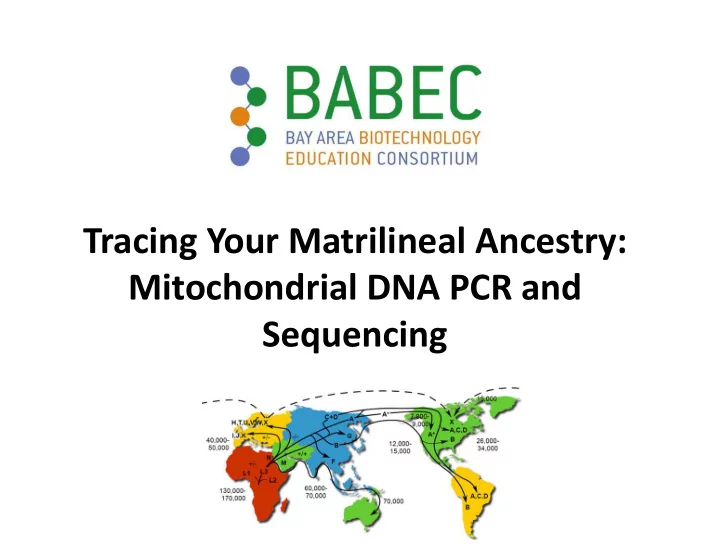

Tracing Your Matrilineal Ancestry: Mitochondrial DNA PCR and Sequencing
BABEC’s Curriculum • Rewrite Curriculum to Align with NGSS Standards • NGSS work group • Your ideas for incorporating NGSS • Feedback from you (evaluation at end of workshop)
Using a Storyline
NGSS Standards • HS-LS4-1. Communicate scientific information that common ancestry and biological evolution are supported by multiple lines of empirical evidence. • HS-LS3-1. Ask questions to clarify relationships about the role of DNA and chromosomes in coding the instructions for characteristic traits passed from parents to offspring. …more after lunch
Pipetting Skills P1000 P200 P20
Lab Workflow 1) Extract your cheek cell DNA using Chelex 2) Amplify 440-nucleotide sequence from the D-loop of your mt genome 4) Analyze your mtDNA sequence 3) Submit PCR samples for sequencing at CSUEB
Lab Activity Follow with your protocol…
How do we start this storyline? • Ask questions. Who are you? Where do you come from? Where are your ancestors from? How do you find out? • Use video? https://genographic.nationalgeographic.com/f or-educators/ “About the Project” first 25 seconds • Any ideas?
What is the Polymerase Chain Reaction A technique in molecular biology used to rapidly amplify a piece of DNA across several orders of magnitude, generating millions of copies of a specific DNA sequence We use this method to copy DNA in vitro to detect specific genes of interest Why? Individual genes are present in amounts too low to be detected in vivo . PCR amplification allows for their detection and measurement from a small sample It produces the double amount of product from the previous cycle, for an exponential increase Image: Aim Shams Univ http://www.obgynacademy.com/basicsciences/fetology/genetics/
Exponential Amplification of Target DNA Sequences PCR products are called amplicons Cycle 3 After 30 cycles, DNA is amplified over a billion fold. Cycle 2 Cycle 1
PCR Reaction Components All components are needed in optimal concentrations Animation: 1.http://passel.unl.edu/pages/informationmodule.php?idinformationmodule =968252315&topicorder=3&maxto=11 2. https://www.dnalc.org/resources/animations/
PCR vs Cellular DNA Replication Cellular DNA Polymerase Chain Cell Replication Reaction What are we copying? DNA DNA Heat Enzymes How do we separate the DNA? Taq polymerase Human polymerase What is doing the copying? Primers Primers How do we fish out the sequence? What does the work? Thermal cycler Cell
DNA Sequencing Images: UCI, Genebase, ABI
Sanger Sequencing Animation From DNALC • https://www.dnalc.org/resources/animations/ sangerseq.html
Sequence Data Results You will receive sequence files from CSUEB with the extension “.ab1” They need special software to open è its open source and free! Sequence text file (.txt) Sequence chromatogram (.ab1) è !
The Science behind this Module
Mitochondria, our “second” genome Food + O 2 = Energy + CO 2 + H 2 O (glucose) (ATP) Powerhouse of the Cell Images: DNLC & Genebase
mtDNA Control Region / D-Loop / Hypervariable Region A gene-free region of ≈1,000 nts like a promoter or origin of replication accumulates point mutations at ≅ 10x rate of nuclear DNA It is our fastest evolving DNA sequence! Over evolutionary time, many more mutations have accumulated in the D-Loop than the coding region. Why? Image: Genebase
mtDNA is Maternally Inherited Why is this significant for ancestral studies? 1) It is not subject to recombination: stays the same throughout generations 2) Changes only occur through mutation, which is passed on 3) Has a strict line of descent from mother to child Image: Genebase
Unique Properties of mtDNA We have many more copies of mtDNA than other DNA Large amount of mtDNA & its small size = excellent candidate for anthropological studies of old or degraded samples The region we sequence has a high mutation rate. It is our fastest evolving DNA sequence! Maternal inheritance gives us specific information about human migration & evolution Because they don't mix with genes from the father's line, mt genes can be used to trace a sort of lineage right the way back to when our first ancestors came out of Africa.
Deep Ancestry Ancestral Marker a mutation that occurred a long time ago Single Nucleotide Polymorphism one nucleotide replaced by another SNPs are the mutations found in mtDNA Common Maternal Ancestors people with the same mtDNA SNPs as you Deep Ancestry: ancestry from tens of thousands of years ago Images: Wikipedia, BBC
Human Origins & Migration ≈ 27 major groups compromise the human race Haplogroup Groups or people with similar haplotypes - they share a common ancestor Haplotype inheritance of a cluster of single nucleotide polymorphisms (SNPs) https://genographic.nationalgeographic.com/science-behind/ The Journey of Your Past Video
Migration Map Interactive • https://genographic.nationalgeographic.com/ human-journey/
Identifying Your SNPs The position of any base pair in the mtDNA is designated by counting from “1ʺ clockwise around the mtDNA Nucleotides in HVR1 region are in locations 16001 to 16520 (low resolution)
Bioinformatics Workflow Bad Reads 1. Obtain .ab1 file 2. Crop off the bad reads using SnapViewer 3. Save as text file (.txt file) 4. BLAST against rCRS; write down SNPs 5. Use mtDNA Haplotype finder at: www.mitomap.org/foswiki/bin/view/MITOMASTER/WebHome 6. Find your Haplotype!
mtDNA Sequence References • Human mtDNA first sequenced in 1981 (called the Cambridge Reference Sequence - CRS) • Revised sequence in 1999 (revised CRS – rCRS) • Differences are explained here: http://www.mitomap.org/MITOMAP/Human MitoSeq • 2012 – a Reconstructed Sapiens Reference Sequence (RSRS) – Uses “mitochondrial Eve” as root Phylotree.org http://haplogrep.uibk.ac.at/blog/rcrs-vs-rsrs-vs-hg19/
revised Cambridge Reference Sequence (rCRS) The first human mtDNA fully sequenced; 1981 Your SNPs are determined based on comparison with CRS your sequence rCRS 3 SNPs: positions 16278(C è T), 16311(T è C), & 16362(T è C)
Recommend
More recommend